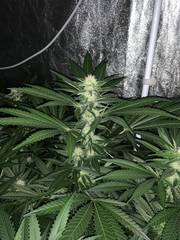Leaderboard
Popular Content
Showing content with the highest reputation on 12/05/2020 in all areas
-
So I've started a small Home grown mix of Lemon Jedi Og. Male (Dark Horse) I think. @Bay Seeds And a very dank Gorilla Glue Cut I received as a gift.. After I grew and flowered the original mother. Mother.. Father.. Dark Horse Genetics Grown by @Bay Seeds Mommy Loaded.. Harvested.. Pale as shit... seeds was not what I normally look for but any way... So started germing them... Keen to see What they do and to get a good male and female together again and again and again... Hope to log all progress here. All nutes and soil is from Freedom Farms. Pro Biotics and Premium Classic soil.4 points
-
The US House of Representatives has passed a bill to decriminalize cannabis at a federal level in an historic first. The move could also pave the way for reassessments of previous federal marijuana convictions. https://www.rt.com/usa/508733-us-house-vote-decriminalize-cannabis4 points
-
Hey guys, I harvested a few days ago. Just wanted to thank everyone for all of their excellent advice. Will be starting x3 auto grows on the 1st of Jan :D Here are some pics from the last few days I gave them a wet trim and then dunked in water, left it outside in the shade for about 5 hours then moved them into the tent for a few days. This was when they were freshly jarred, I burp them 2-3 times a day now and try to keep humidity at 60-65% My yield was 53g wet, which I don't think is bad considering it being my first grow and the plant coming back from the brink of death haha3 points
-
Day 26 of flower. Girls are looking good and the gelato pollen donor is doing her thing. Pics are mixed bud shots of the spumoni, slurricane, Blunicorn, chocolate gelato3 points
-
Auto Kabul Sent from my SM-N975F using Tapatalk3 points
-
Awesome man. Great that you posting this up. Keen to follow on other local micro breeding projects.2 points
-
I have Ruderalis Indica growing.. but you can't expect monsters from basic ruderalis, those are survival specialists not yielders. I run them for male pollen and a batch of fresh seeds. Very solid plants and for the week of grow time.. smaller side. I just use them as timers to turn photos into autos. not sure you want to extract them, can't be on the potent side, not "their" thing in free nature. At least to my understanding.. If you want a special effect, go for the special CBD plant.. Pain, check for a Harlequin, Insomnia, look for a Wild Fire 47 or epileptic episodes, Charlotte's Web... extract those or what ever plant you need. People invested time into those. The cool thing on the ruderalis is not the effect on the body. Why so famous, is the canceling of the photo effect on the plant, light duration has no effect on flowering time anymore. I feed them a LOT less ^^ main difference2 points
-
Hey guys, Finding a reliable courier service for Golden Goose was a nightmare. Logistics can literally sink an online business, especially an online business operating within the canna industry. So it was really important for us to find a decent courier company. Unfortunately, that doesn't always equate to the cheapest courier company. I started investigating all the usual logistics companies, and I soon realised that this was going to be alot harder than initially thought it would be. I spoke to plenty of other online operators in the canna industry, and the stories I heard about service levels from these guys was scary. We eventually chose Postnet/Aramex at R79 postnet-postnet and R109 postnet/door. These are flat rates to any destination in SA. We negotiated for the possible best rate we could get. Time will tell if we made the right choice, but I have a good feeling about these guys. I want to assure everyone, that delivery service is of the utmost importance to us.2 points
-
I kept both males, I figured they were crazy expensive and why not keep both. You dropped your plant off just as my two males were coming into flower. She stood right next to the 2 males. We hand pollenated from the purple one only. That's her in the black pot with the green delsticks.1 point
-
Will germ some of The Fire you gave me beginning next year. Might have a actual grow space to myself soon... Would be a awesome start to 2021 after this horrid 2020... still kicking me in the nusts and it's December already....1 point
-
Enjoying the sun with gratitude Sent from my F5321 using Tapatalk1 point
-
That's very good to hear! Thanks for posting your feedback on their service. The few deliveries they have done for us already, have gone very smoothly. So no complaints from my side either at this point.1 point
-
I can vouch for PostNet. Couriers charge a premium to deliver out to the reservation, that's if they actually find us. Have not been able to yet. Seeds sent via PostNet, watch your parcel using their tracking app, leave the reservation for the closest village and collect. Boom, plant seeds. Believe it or not post office has a similar service but be prepared to wait about a week. Sent from my DRA-LX5 using Tapatalk1 point
-
1 point
-
That is a very important part to the bill and hopefully the senate passes it. Exciting times.1 point
-
Howzit guys, this is the diary of my first grow. Strain: Strawberry Banana Cheese Indoor Grow Equipment 80 x 80 x 180cm grow tent Freedom farms soil 240W Quantum Board x2 Clip on oscillating fans, x1 extraction fan Germination: 10/08/2020 Vegetative: 16/08/2020 Flower: 16/10/2020 14 - 08 - 2020 Latest: 02 - 12 - 20201 point
-
1 point
-
Hey brother, thanks for the response. I agree they are a little pricey. We will work on trying to get them in a bit cheaper in future. Who knows... there might be a special or a competition in the not too distant future.1 point
-
While we are on the subject of microbes and fermentation, I would like to raise an important issue that I see is a real problem. There are countless articles and videos on the internet on organic gardening advising people to leave tap water in a container standing overnight to supposedly get rid of the chorine in the tap water. As anyone that keeps freshwater fish will know, this is a big mistake that many organic gardeners keep on making. The first problem is knowing if chlorine is really the only issue or if chloramines are present in the water. Chlorine is a very volatile gas and hence why people are advising to just let the water stand to get rid of the volatile gasses. This is called off-gassing the chlorine. Let's assume for a moment that chlorine is the only problem and you are trying to get rid of it by letting the water stand overnight. 2 ppm of Chlorine can take up to 5 days to evaporate from 50 liters of standing water. Ultraviolet light, water circulation and aeration, temperature and the area of the surface of the water exposed to the air will speed up the off-gassing process. None the less, it's very unlikely that you will get rid of even half the chlorine in a container by just letting in stand overnight. Due to this volatility and rather instability of chlorine, local authorities and governing bodies today are switching to using chloramines instead. Chloramines give off much less of that familiar chlorine odor and the water tastes much better as well. Unlike chlorine, chloramine does not evaporate so easily from water. Chances are pretty big if you are using municipal tap water, that it has been treated with chloramines, rather than, or in conjunction with chlorine instead of chlorine only. You can get rid of chlorine and chloramine by boiling. It takes a considerable amount of boiling to get rid of chloramine though. 1 ppm of chloramine in 40 liters of water will need to be boiled for at least 1 hour to get rid of all the chloramines. Not really a practical option. My advise is to use a chemical option to neutralize any chlorine and chloramines present. My favorite two options are ascorbic acid and sodium ascorbate. Ascorbic acid will lower the Ph of the water, while sodium ascorbate is Ph neutral and will not change the Ph. Very little is required of either ascorbic acid or sodium ascorbate to neutralize the chlorine and chloramine in water and these are easy to come by and rather cheap as well. If you buy 500mg ascorbic acid tablets from the pharmacy, you can use 1/4 tablet (125mg) per liter of water. Theoretically, you can use even quite a bit less than that, but I've been using this ratio for a very long time with success. Note: A water quality report from Tshwane June 2020 (my local gov) shows Monochloramine levels at average rate of 1.24mg per liter and free chlorine at 0.09mg per liter. This shows a rather big inclination to treat water with chloramine.1 point
-
This is my ethos autoflower. Pluto Cut. I will most definately grow it again. Tennis ball sized budz.1 point
-
Alright, fair enough. If you want, why not consider a plant specifically bred for high CBD levels? If you have any specific questions regarding Ruderalis or autoflowers, let us know and I am sure one of the members can assist.1 point
-
For any low tech members, an easy way to remove all info from a pic is open the pic, copy, open MS Paint, paste, save as what ever you like, info is gone on this copied picture...1 point
-
Autoflowers are fussy plants. If you dont know them. The plant will start flowering independent of light cycle. What you have to know is the plant will start flowering as soon as the tap root hits the bottom of the pot. Thus you need to plant them in the pot you want to flower in. I recommend a 20l pot for outdoors. Also they don't want to be fed heavilly. The need a very airy soil. Buy the right genetics. Mephisto, nightOwl and ethos has some amasing flowers.1 point
-
Hi guys, a few more update pics below. Not sure about this yellow leaf, there's another one at the back of the plant. Only the big fan leaves are that colour. Any idea what it is?1 point
-
This is a good read, thought I would also share it here, a very long version (tips from various sources) is in the Breeders Group if you find this interesting. Happy growing 420SA! Breeding tips:How to bring out the Sativa and breed the ultimate buds.To understand the principles behind the breeding of cannabis you first need to be familiar with some basic terms related to genetics. "Genotype" is the genetic and chromosomal make-up of any given individual — it is the genetic code. "Phenotype" is the expression of body type, structure, and appearance of individuals; it results from the interaction between genotype and environment.Specific environmental conditions are often required for certain phenotypic expressions from a given genotype. If the available nutrients, hours of sunlight, or other conditions are not available then the development of the plant or animal will be altered. These conditions are referred to as "environmental triggers."Two individuals with the same genotype can have greatly different phenotypes if grown in different environments.Indoor vs outdoorIn terms of growing and breeding cannabis, there is a distinct difference between indoor and outdoor grow environments. No matter where on the planet one is, the indoor environment is usually far more limited when compared to the spectrum of conditions existing outdoors.When compared to the wide variety of conditions available outdoors, the indoor environment may be seen as relatively bland and generic. The greenhouse environment, especially when fortified with electric light, is perhaps the closest thing available to a happy marriageThree subspeciesIt is useful to agree, at least in theory, that there are three separate subspecies of the genus Cannabis — Sativa, Indica and Ruderalis.Cannabis Sativa is the equatorial variety found primarily around 30 degrees latitude North or South. Sativa generally grow tall, from seven to thirty feet, have many long branches, narrower leaflets, and mature slowly.Cannabis Indica varieties generally inhabit the areas between 30-50 degrees North or South latitude. Indica are generally much shorter than Sativa, only about three to five feet tall. They have fewer and shorter branches than Sativa, the longer of which are lower on the plant, with much wider leaflets. They also mature earlier and more rapidly than Sativa.Cannabis Ruderalis grow naturally primarily past 50 degrees north latitude (the Siberian steppes). Ruderalis are the shortest, least bushy, and fastest maturing of the three.The end of the sweet spotsPrior to the late 1970's, virtually all commercially available cannabis products came from the great outdoors. Many of these varieties had been grown in their particular region since antiquity — not since the advent of sailing had a greater diversification and distribution of the herb occurred.Most cannabis available was also very well acclimated to its particular region of origin. Certain places tended to produce very unique and desirable types of herb that were renowned to each region. I like to refer to these high-quality cannabis producing areas as "sweet spots." The products coming out of these sweet spots during this era were among the finest herbs ever available.A series of phenomena occurred in the late 1970's and early 80's that has since revolutionized the cannabis industry. This series included the triad of sinsemilla, High Intensity Discharge (HID) lighting, and the introduction of Indica genetics, coupled with draconian herb laws that drove the industry far underground. Never before in human history was so much genetic diversity of cannabis grown in such generic, indoor conditions. The results of this phenomenon have wreaked havoc on the cannabis gene pool.The road to blandnessAs Indica, sinsemilla and HID lighting became predominant, it became apparent that Sativa varieties were very difficult to coax commercial amounts of sinsemilla herb from indoors. The fast maturing, dense bud structure of the easy-to-grow Indica soon dominated the indoor grow scene.Another factor contributing to the desirability of the indoor Indica was its truebreeding "dioecious" nature, meaning that individual plants tend to be male or female only, but not both. In contrast, many Sativa strains show hermaphroditic tendencies indoors, with male and female flowers on the same plant. (It is my opinion that wild Sativa strains of cannabis are primarily truebreeding hermaphroditic varieties.)As outdoor production diminished due to intolerant laws and the drug war, indoor production of Indica phenotypes became the staple of the commercial indoor grower. The road to generic blandness had begun.Although some Sativa/Indica crosses matched some of the Sativa flavor and head high with the Indica bud structure, this desirability would only last for a few generations of breeding. Unless a person is breeding for a very specific trait, crosses seven generations and beyond the original P1 Indica/Sativa cross lose much of their original charm and desirability. Cloning, however, helps to extend a given plant's potential.Ruderalis: myth and misnomerAs indoor growers attempted to improve their genetic lines via breeding, another interesting phenomenon occurred: Ruderalis. Although there is a wild variety identified as Ruderalis in Russia ("Ruderalis" is supposedly Russian for "by the side of the road") that grows very short and matures very fast, I seriously doubt the rumor that someone actually went to Russia to collect seeds of this variety sometime in the past. Or, if someone actually did go all the way to Russia to find, collect and smuggle "rudy" seeds, I do feel sorry for their waste of time. They could have gotten the same worthless thing from Minnesota, Saskatchewan or Manitoba with much less hassle.The North American Ruderalis probably originated as follows: After the Indica varieties arrived in the US and became incorporated into the gene pool, many breeders began to cross the earliest maturing individuals with each other in hopes of shortening the maturation cycle.It would only take a few generations for the ugly Rudy phenotypes to begin expressing themselves. By ugly, I am referring to a strong lack of potency and/or desirability. I know, I was once guilty of the practice myself. It did not take me long to realize that this was a huge mistake in regard to the quality and potency of the future generations' finished product, and all subsequent breeding along this line was ceased.Many of these manipulated rudies were released on the open market between 1981 and 1986. It was shortly after this period that the grow journals of the era (Sinsemilla Tips and High Times) ran articles about the possibility of a new wonder variety for indoor grows: fast blooming Ruderalis. Rumor had spread to myth and misnomer. Therefore, it may be more appropriate to say that the Ruderalis phenotype was coaxed from Indica genetics, via the indoor breeding environment.The same applies to many of the Indica dominant varieties available today. Breeders selecting for early, fast flowering or fast growth often miss out on some of the finer and more subtle characteristics available from crossing certain genotypes. My advice to breeders is to wait until the finished product is suitably tested before coming to any conclusions regarding desirable candidates for future breeding consideration.Phenotypic expressionThe malleability of phenotypic expression among the Sativa/Indica crosses must also be noted. The variability of phenotypic expression among the f2 generation of a truly polar (pure Sativa/pure Indica) P1 cross is quite phenomenal. The second generation f2 crosses will exhibit the full spectrum of possibilities between the original parents — extreme Indica, extreme Sativa, and everything in between.However, regardless of any particular phenotype selected from among this given f2 cross, future generations may drift radically. Depending on the presence (or lack) of a number of environmental triggers, an f2 Indica phenotype may be coaxed more toward Sativa traits, or an f2 Sativa phenotype may be coaxed more toward Indica expression. The key is environmental conditions.This is what distinguishes the truebreeding, ancient acclimated, region of origin varieties — especially the tropical and equatorial Sativa — from the crosses that have happened since. The ancient specimens have a much narrower genotype range, and therefore a more specific phenotype than their contemporary crosses despite environmental conditions. It is up to future adventurers to provide the best possible environmental considerations, along with the best possible genetic considerations, in order to resurrect the legendary happy flowers of yore.Inducing SativaAfter many years of first-hand experience breeding herb indoors as well as outdoors, I am of the opinion that the two most influential factors involving phenotypic variation and expression among current indoor herb breeding projects are the photoperiod (hours of light per day) and the angle of light in relationship to the growing plant.Specifically, I find the single most powerful influence to the Indica dominant phenotype is the traditional 18/6 veggie cycle and 12/12 flowering cycle. The 18/6 veggie and 12/12 flower cycle is an attempt, however poor, to mimic the Indica-producing photoperiod. It is my belief that this light cycle strongly influences for Indica phenotypic expression.Sativa phenotype characteristics will manifest under a more equatorial photoperiod, closer to a 13/11 veggie cycle and an 11/13 flower cycle. This is the light timing range to use to elicit more Sativa dominant expression from your plants.As for the exact photoperiod formula that I incorporate into my growing/breeding regime, this will presently remain a trade secret. My advice is to experiment with different photoperiods, keep good notes and pay attention. Avoid the 18/6 and 12/12 photoperiods, while tweaking the times a bit differently with each breeding cycle until more desirable results in the finished product and their offspring are noted. Here's a hint: work in half-hour increments or a little less, and good luck!Angle of LightAngle of light simply refers to the physical angle of light source the plant is dependent upon for growth. Perhaps the greatest difference between indoor and outdoor environments has to do with the angle of light received by the plant. This is also one of the greatest seasonal differences between the Sativa and Indica producing regions.Outdoors, the main light source is the Sun, with minor influence coming from nearby reflective surfaces. As a plant grows taller and broader outdoors, that angle of light from the sun changes very little in relationship to the growing plant.Seasonal changes in angle of light increase the further away from the equator one gets. At the equator there is the least amount of seasonal change in angle of light, only about 20°, whereas at the 45th parallel that change is as great as 45°. At the 45th latitude, the Summer Sun is high in the sky while during early Spring and late Fall the sunlight comes from much lower in the sky. The farther one goes from the equator, the greater the difference in seasonal changes regarding angle of light.Indoors, the lights typically range from a few inches to several feet from the plant. As the plant grows taller, its physical relationship to the bulb's angle of light changes considerably. Most indoor grow rooms have relatively low ceilings, therefore, raising the bulbs may maintain a similar angle of light early on, but eventually the angle changes. The same differences may be noted among plants directly below the bulb and the plants off to the side of the room farther away from the bulb.Circular light shuttles tend to emulate the arctic summer and create a confusing signal completely unknown to the equatorial Sativa. Straight-track overhead light shuttles are more conducive to inducing the Sativa phenotype.Aromatics and flavorsMany indoor growers try to get their budding plants as close to the light source as possible. Though this may increase bulk production of both bud and trichome, I find that this practice tends to destroy many of the finer aromatic qualities of the herb.Buds too close to the light tend to express nothing beyond the lower lemon/lime aromas of the fruity spectrum. Sometimes the aroma is no better than a strong chemical/astringent odor and flavor, especially those under High Pressure Sodium light systems. The finer berry flavors tend to favor more distance from the bulb, and will manifest more strongly under High Ultraviolet Metal Halide light systems, especially during the latter stages of flowering.Something akin to a gymnasium building with high ceilings and super 5000W lights hung far from the growing plants, set at a Sativa-tweaked photoperiod, would be the ultimate indoor grow-op to coax Sativa phenotypes.Sweet spot fantasyNothing will ever rival the great outdoor sweet spots for quality cannabis production. Hopefully, someday, somewhere, someone will be daring and lucky enough to get away with re-establishing some of the great genetic lines in their specific region of origin sweet spots.Equatorial Sativa varieties are of interest for quality herb production (Thailand, Oaxaca, Colombia, Central Africa, etc.) as the Indica zones are more renowned for hashish production. Parts of Nepal tend to produce both excellent hashish and fine Sativa buds, with some plants reportedly living longer than two years!I hope that I am able to live long enough to once again experience the joy associated with the fine herbal products from the great regional sweet spots of near ancient lore. It has been a long time and I am looking forward to the day.by DJ Short1 point
-
Gave up gaming when starcraft 1 came out. The only game I play is online, Mudd and Blood, its my Solitaire every few months. Some of the games comments are hilarious and I just enjoy it.0 points
This leaderboard is set to Johannesburg/GMT+02:00






.thumb.jpg.40fa3417bb8f746949f0efeca5d720c1.jpg)












